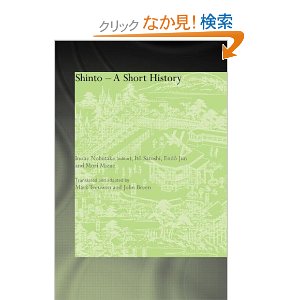‘Shinto – A Short History’ ed. Inoue Nobutaka tr. and adapted by Mark Teeuwen and John Breen
London: RoutledgeCurzon, 2003 223 pages, medium size. ISBN 0-415-31913-7 approx. $30
Given the amorphous nature of Shinto, this collection of articles does not attempt to define it but to describe how it was practised in different eras. It does this through a study of participants, institutions, and teachings, which helps to highlight the continuities and discontinuities. The value of this is that Shinto is presented not as something unique, insular, and fixed, but as a pragmatic set of practices that form part of the East Asian religious sphere. There are four chapters and an introduction by Japanese academics from different disciplines. Between them they cover ancient Japan and the emergence of Shinto; the medieval period and the merging with Buddhism; the early modern period with its search for a Shinto-inspired national identity; and the modern age with the formation of State Shinto and its postwar legacy. The writing is academic, not always easy reading, but at pains to be accurate and impartial. As such it makes a powerful argument, which will be welcomed by Green Shinto sympathisers as an antidote to essentialist and nationalist interpretations.
helps to highlight the continuities and discontinuities. The value of this is that Shinto is presented not as something unique, insular, and fixed, but as a pragmatic set of practices that form part of the East Asian religious sphere. There are four chapters and an introduction by Japanese academics from different disciplines. Between them they cover ancient Japan and the emergence of Shinto; the medieval period and the merging with Buddhism; the early modern period with its search for a Shinto-inspired national identity; and the modern age with the formation of State Shinto and its postwar legacy. The writing is academic, not always easy reading, but at pains to be accurate and impartial. As such it makes a powerful argument, which will be welcomed by Green Shinto sympathisers as an antidote to essentialist and nationalist interpretations.
Summary: Not likely to appeal to those looking for easy overviews or practical information, but valuable for anyone seriously interested in an alternative view of Shinto history.

Leave a Reply